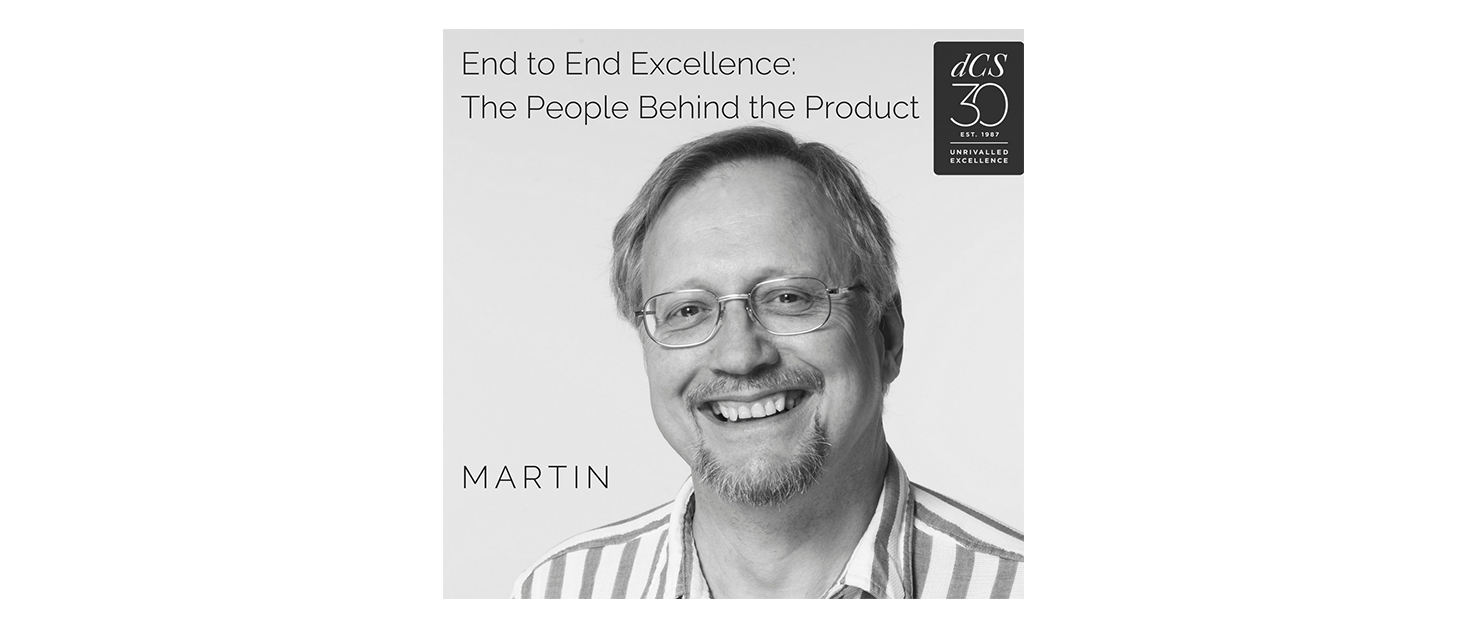
End to End Excellence: The People Behind The Product - Martin Reynolds
In the latest in our series celebrating the people who make dCS, we talk to Technical Support Specialist Martin Reynolds about his childhood love of science and electronics, prototyping one of the world's first CCTV cameras, joining the world of hi-fi, and helping dCS customers
Tags: Design & Craft,Originally from North West London, Martin Reynolds proved a bit of a boffin at Harrow County Grammar School. He won the school chemistry prize, and took a great interest in science. “I loved electronics and hi-fi too,” he says. “Things were very tight in those days, back in the 1970s. I used to buy Wireless World magazine and from the age of around 15, began to cobble together enough money to buy parts for an amplifier. It sounded great, but only because I made it myself!”
Martin went on to take his 'O' and 'A' level exams a year early, "then found I was too young to go straight on to university," he adds. "I spent most of 1975 with the Post Office Research Department, where I was put in charge of an experimental facility making lasers for telecommunications applications. It was interesting stuff, and involved a mix of chemistry and electronics, which suited me down to the ground. Then I went to the University of Kent, and studied electronics. I graduated about third in my class, so knew my way around a circuit diagram better than many…”
“I dived in with both feet”, says Martin. “I loved my specialist subjects, and spent the summer vacations at GEC Research Centre in Wembley. They had some interesting things to throw at me – I was hand-wiring experimental computer boards using the old 8086 processors. It was absolutely cutting-edge stuff at the time, but incredibly slow by today’s standards, of course. Although they were only 8-bit, when you had to wire every bus by hand it took some time. These days you’d put a circuit on an auto-router and it would route the board for you by magic. Then in 1976, I was tasked with prototyping one of the world’s first digital closed circuit television cameras, which had a staggering 9 kilopixel resolution!”
"Although I joined as a design engineer, they discovered my talent for taking things that weren’t working properly and modifying them"
Martin went on to join the hi-fi industry, working with Bill Beard of Beard Audio Systems. "He started up as a cottage industry producing premium tube power amplifiers which sounded really, really good. Compared to anything I could afford to make at the time, they were amazing. Of course, they were quite easy to design, with standard tubes such as KT88s, ECC83s ECC81s and so on. We got some great reviews at the time, but they were too big for my digs in Clapham so I never owned any, sadly. It was the first incarnation of the valve revival – even in the late 1970s, they were considered antique, and most people had abandoned them. But some great tube amps came out back then and blew the market’s ears off. A large part of this was their Class A operation…”
Martin recalls Beard Audio being a fun place to work. “Being a so-called cottage industry you had to do pretty much everything yourself. Initially there were two of us and it grew up to about five. I loved it, but after five years I decided it was time to move on. I got married, got a new job and found myself at Neve Electronics designing high end studio mixing consoles. Like dCS now, this was a highly prestigious company to work for. Although I joined as a design engineer, they discovered my talent for taking things that weren’t working properly and modifying them so they did. So I found myself in charge of the Product Support department, in addition to designing new consoles from scratch, eventually to lead the analogue R&D department. I was there for a decade, leaving not long after we had won The Queen’s Award for Industry.”
"What I love most is when people I’ve advised end up even happier about the product than they were before – especially if you show them something that they weren’t even aware that it could do.”
Martin went on to join dCS in 1996, managing the development of the company’s first hi-fi product, the Elgar DAC, which was a ‘domestic’ version of the pro market 952. “We kept the pro business going as that was one iron in the fire, and then developed the consumer audio business. We got great reviews for Elgar and then started developing products to go around it. We discovered the upsampling effect because one of the next projects I managed was the 972 digital-to-digital converter, which was sort of digital audio Swiss army knife. It allowed studios to convert almost anything into almost anything else. There was just nothing like it at the time.”
“The basic design of the Ring DAC was very sound, and every generation sounds quite noticeably better than the last. I was surprised by how much better the Scarlatti sounded than the classic stack, and the Vivaldi just blew me away. That’s the way it works, you make the design as clean and as sanitary as you can and it responds with sonic improvements. Digital technology keeps on moving in leaps and bounds and you get the knock-on effect of processing power that is available in mobile phones. Every time we get more power, we have more scope for adding new features. The classic range ended up with an awful lot of extra functionality compared to the initial release. We are doing our level best with the new capacity, keeping the design as streamlined as possible. Rossini is a perfect example, with just one huge FPGA that does nearly everything, with the DSP and micro controller piled into that huge chip.”
These days, Martin is focused on delivering technical customer support. “I have been writing the user manuals for the last 20 odd years, so I’m probably the one person in the company who knows the whole product range best,” he confesses. “Most folk I deal with are lovely, and make me feel like I have made the world a better place. What I love most is when people I’ve advised end up even happier about the product than they were before – especially if you show them something that they weren’t even aware that it could do.”












